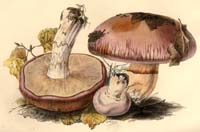 Key to Gilled Mushrooms Key
Key to Gilled Mushrooms KeyThis is a key to gilled mushrooms, that is, mushrooms having a definite cap with a fertile surface consisting of gills. The fruiting body usually also has a stem, although that may be lateral or absent (usually, then, the mushroom is growing from wood). You can use this key to identify mushrooms that you find.
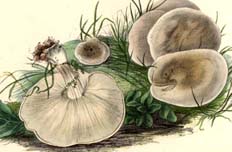 Agaricales Order
Agaricales OrderFruiting body containing fibers (usually in the stalk)
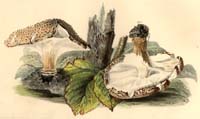 White Spored Suborder
White Spored SuborderSpore print "light-colored": white or buff, sometimes tinged with pink or tan. Greenish and (except for the Russulales) yellow spore prints also go here
Stalk fibrous, not fracturing like a piece of chalk
 Tricholomataceae Family
Tricholomataceae FamilyNone of the special features distinguishing the other white-spored genera:
Gills not free, as in the Lepiotas and Amanitas
Basidia not extra-long, as in the Hygrophoraceae
Spores smooth, except for Lentinellus
 Lignicolous Trich Subfamily
Lignicolous Trich SubfamilyGrowing on trees or dead wood, leaves, or sticks, or organic debris, often in moss
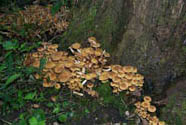 Normal LignoTrich Tribe
Normal LignoTrich TribeShaped like a “normal mushroom”
Small and fragile to medium-sized, except for one large, grey-capped species
Small Ligno Trich SubtribeFruiting body small: cap up to 1 1/4" across (and most clearly smaller than that)
Marasmius Genus Fries
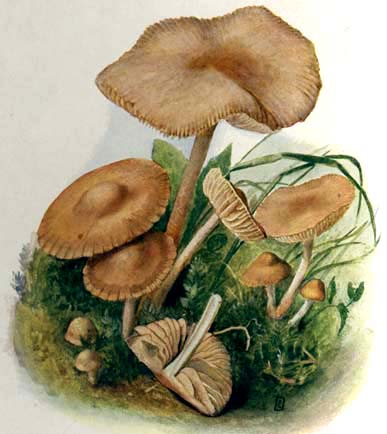
Diagnosis
- Basically, the members of this genus can look like members of any other SmallLignoTrich.
-
You might want to check here first if your mushroom is very small, has a thin, wiry stem or is revenant. Or if it looks like the picture. :-)
-
Else, check this genus if you can't find your mushroom anywhere else
Microscropic Characters
Comments
We tend to think of these fungi as just cute little wood-rotters. But many of them are actually facultative parasites that cause major problems with cash crops in warmer climates. The rhizomorphs that we usually ignore up here are used to penetrate and feed upon nearby plants. So pay attention to those rhizomorphs!
Narrow down your identification:
Marasmius androsaceusCap up to 3/4" across
Stipe wiry, concolorous with cap at apex, darkening to black below; attached to black, wiry rhizomorphs
Singly or in troops; usually on coniferous forest litter, but sometimes on deciduous
Marasmius capillarisCap up to 1/2" across, hemispherical becoming omphaloid; brownish with a white center
Stalk hollow, wiry, darkening to very dark brown from the base up
Gills distant
On dead leaves, especially oak
Marasmius cohaeransCap up to 1 1/2" across, yellowish brown
Gills white, yellowish pink to dull greyish brown.
Stem hollow, shiny; white at top, shading to color of cap at bottom
Growing cestipose on hardwood forest litter, the base of the stalk(s) attached to a white or yellowish wad of mycelium that usually binds quite a bit of the substrate
Marasmius delectansCap up to 1 1/2" across, ochre soon fading to white; gills concolorous
Stem up to 3mm wide; at first concolorous with cap, then darkening to dark brown (not black!) from the bottom up
On deciduous litter (especially oak, according to A. E. Bessette, D. W. Fischer & A. R. Bessette (1997) )
No rhizomorphs
Sometimes with a fetid or spermatic odor, according to A. E. Bessette, D. W. Fischer & A. R. Bessette (1997)
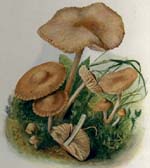 Marasmius oreades
Marasmius oreadesCap at first brown, campanulate, smooth and almost shiny; becoming flat with an umbo, faded to tan and dull; up to 2" across but usually only 1- 1 1/2"
Gills white at first, becoming concolorous with cap, adnexed
Stem easy to snap when the cap is still campanulate, becoming very tough and flexible: pull on the stem and the whole thing comes right out of the ground with a sparse tuft of substrate attached
In grass, often in fairy rings
 Marasmius rotula
Marasmius rotulaCap up to 5/8" across; hemispherical and radially flat at first, becoming omphaloid and sulcate
Entire fruiting body yellowish white at first; cap lightening to white
Stalk hollow, wiry, darkening to very dark brown from the base up; base with sparse, wiry, dark brown rhizomorphs
Gills distant (they're too close in the picture), originally attached to a collar rather than the stalk itself; the collar, however, soon collapses onto the stalk
Cestipose on deciduous wood
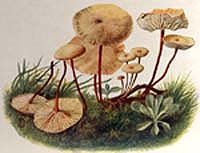 Marasmius scorodinus
Marasmius scorodinusSmelling of garlic
Cap reddish or yellowish brown when young, hemispherical with an inturned margin; aging flat, up to 1 1/4" across, fading to tan
Stem smooth, brittle, yellowish at the top, reddish brown below
Marasmius siccusCap up to 1 1/4" across, orange-brown or rusty brown (bittersweet); hemispherical and radially flat at first, becoming omphaloid and plicate
Stalk wiry, darkening to very dark brown from the base up
No rhizomorphs
On deciduous forest litter and white pine needles

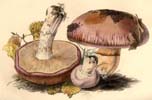


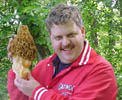

 Key to Gilled Mushrooms Key
Key to Gilled Mushrooms Key Agaricales Order
Agaricales Order White Spored Suborder
White Spored Suborder Tricholomataceae Family
Tricholomataceae Family Lignicolous Trich Subfamily
Lignicolous Trich Subfamily Normal LignoTrich Tribe
Normal LignoTrich Tribe
 Marasmius oreades
Marasmius oreades Marasmius rotula
Marasmius rotula Marasmius scorodinus
Marasmius scorodinus




